2023
Legal Trends for Solo Law Firms
Introduction
What distinguishes a solo lawyer?
- Introduction. What distinguishes a solo lawyer?
- Part 1. A widening gap
- Part 2. Solos work in more than one location
- Part 3. Pros and cons of flexible work schedules
- Part 4. Maintaining a competitive edge
- Appendix A. App data collection
- Appendix B. Survey design
Solo lawyers make up a strong and vital contingent—one that represents a unique form of practice—within the wider market for legal services.
For many solos, practicing on their own often means prioritizing leaner operations and a greater degree of freedom in how they work. At the same time, they pride themselves on offering more tailored client experiences rooted in deeper, hands-on relationships.
The Legal Trends for Solo Law Firms report looks at what distinguishes solos from larger practices. Since there is no one-size-fits-all measure of success, this report provides insight into key trends across multiple perspectives—including financial performance, personal and professional well-being, and client relationships.
By analyzing these insights, we identify where solo law firms often face their greatest challenges and how they can work toward overcoming them.
Since there is no one-size-fits-all measure of success, this report provides insight into key trends across multiple perspectives.
A distinct—and evolving—legal experience
There is no denying that owning and operating a solo practice comes with its own challenges. While solo lawyers operate outside of the organizational processes and constraints that come with working at a larger firm, they also face the burden of bearing sole responsibility for every detail of their practice.
Since solos have only themselves to rely on, they’ve also been innovators when it comes to implementing new forms of legal technology to help manage their firms and find new efficiencies. In fact, the use of cloud-based legal practice management (LPM) software has become almost universal among solo practitioners.
But while solos have enjoyed a significant advantage in technology adoption, larger firms have rapidly adopted cloud-based technologies since the advent of the COVID-19 pandemic.1 This adoption has enabled larger firms to create more efficient and distributed work environments—the likes of which solos have been pioneering for more than a decade.
Technologies are still fast-evolving, and with them client expectations for fast, efficient, and seamless experiences with their legal professionals. To stay at the forefront of innovation, solos will need to find new ways to distinguish themselves from larger firms.
To stay at the forefront of innovation, solos will need to find new ways to distinguish themselves from larger firms.
Solos versus non-solos
For this report, we’ve compared solo law firms to the category of “non-solos,” which captures law firms with greater numbers of lawyers and support staff. It’s a broad group to compare to, but in doing so, we’ve been able to shed light on distinct work patterns among solos. While no firm size is objectively better than the other, there is no denying that as the structure and makeup of firms differ, the context and circumstances for those who work in them differ as well.
However, the principles and values followed by solo lawyers are not only applicable to them. The report’s findings can also be useful for firms that operate similarly, with low overheads, remote work arrangements, and less managerial supervision.
We’ve been able to shed light on distinct work patterns among solos.
Data sources
This report uses a range of methodological approaches and data sources to deliver the best insights about the state of legal practice and strategies for future improvement.
Clio data
We’ve analyzed aggregated and anonymized data from tens of thousands of legal professionals in the United States, segmented based on firm size, to observe differences in usage patterns among solo and non-solo law firms. This data provides important insights into how firms of different sizes are using technology, and its impact on performance. This analysis includes data collected between January 2019 and December 2022.
Surveys of legal professionals and consumers
We surveyed 1,134 legal professionals, segmented based on firm size, to distinguish and compare responses between solos and non-solos. Additionally, we conducted surveys of 458 professionals from other industries and 1,168 consumers to compare trends beyond legal professionals. The consumers included in this survey represent the US population by age, gender, region, income, and race/ethnicity based on the most recent US census statistics. We conducted all surveys in April and May 2022.
Location data
We used aggregated and anonymized IP address data to analyze where lawyers are working from and how this has changed over time. We also segmented this data to compare usage patterns between solos and non-solos. This analysis includes data collected between January 2019 and January 2023.
[1] Part 4 provides more on technology adoption among larger firms. The 2021 Legal Trends Report also provides data on wider industry trends.
2023
Legal Trends for Solo Law Firms
Part 1
A widening gap
- Introduction. What distinguishes a solo lawyer?
- Part 1. A widening gap
- Part 2. Solos work in more than one location
- Part 3. Pros and cons of flexible work schedules
- Part 4. Maintaining a competitive edge
- Appendix A. App data collection
- Appendix B. Survey design
By looking at aggregated and anonymized data from tens of thousands of legal professionals using Clio, we’ve benchmarked major trends in business performance throughout the legal industry since 2019.
For solos, this data provides valuable insight into understanding how their businesses compare to others in the industry while identifying key factors for assessment and improvement.
While solos have maintained a stable level of business in the last two years, they are seeing only a small fraction of the growth in collected revenues compared to larger firms.
State of the legal industry
Like all law firms, solo practices saw the demand for legal services drop during the emergence of COVID-19 in 2020. While caseloads fell, however, solos managed to keep their revenues steady. Demand for legal services bounced back significantly in 2021, which saw solos grow revenues beyond what they collected even prior to the pandemic.
Non-solo law firms saw similar challenges in 2020 yet increased their casework even more substantially in 2021. The increase in overall billable hours combined with the increases in hourly rates resulted in nearly double the growth in overall collections for non-solo law firms compared to solos during that year.
Demand for legal services has since leveled off in 2022 for both solos and non-solos. However, non-solo law firms have still managed to significantly increase their billable hours and achieve nearly double the overall revenue growth as solos.
In other words, while solos have maintained a stable level of business in the last two years, they are seeing only a small fraction of the growth in collected revenues compared to larger firms.
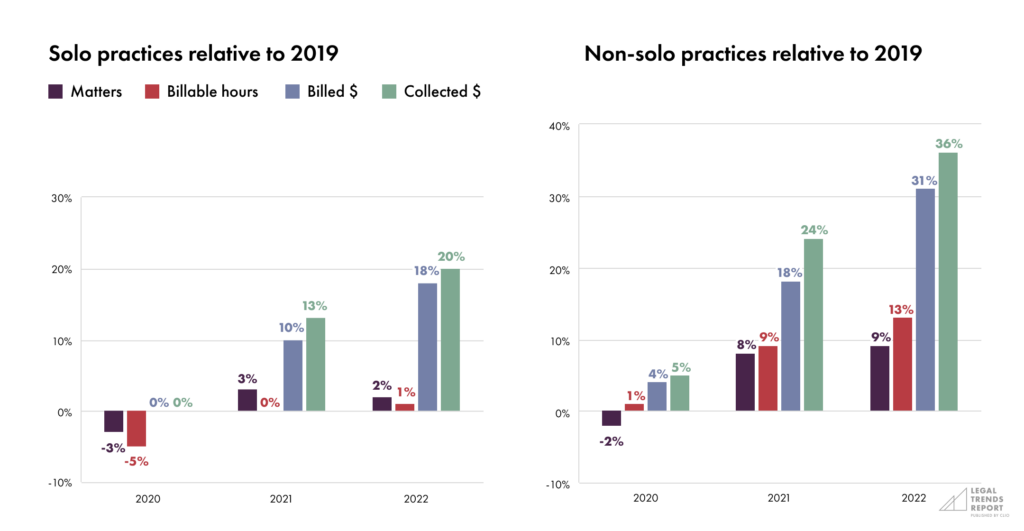
Demand for legal services has since leveled off in 2022 for both solos and non-solos.
Key performance indicators
Key performance indicators (KPIs) provide insight into how a business is performing toward its goals. Law firms seeking to improve their revenue should pay attention to three KPIs in particular:
- Utilization rate is the number of hours put toward billable work as measured against an eight-hour workday.
- Realization rate is the proportion of billable work that gets billed to clients.
- Collection rate is the proportion of billed work that gets collected.
Each KPI significantly affects the next, and when looked at together, they show how well a business is performing in terms of its earning potential. For example, firms with a low utilization rate only put a small amount of their work hours towards billable work, which limits the number of hours that can eventually be billed and collected. Low realization and collection rates hinder a firm’s earning potential further.
Even though solos may find themselves working just as much as (or even more than) lawyers at larger firms, less of their time is put towards actual billable hours.
Solos work fewer billable hours
Solo utilization rates are about 11% lower than non-solos, which likely means two things:
- Many solos have struggled to find the time to put towards the clients they have, which could be a reflection of having to balance their days with a significant amount of non-billable administrative work.
- Many solos have struggled to bring in clients to their firms.
In either case, even though solos may find themselves working just as much as (or even more than) lawyers at larger firms, less of their time is put towards actual billable hours.
For example, in 2022, the average utilization rate for solo lawyers was just 25%, which amounts to just two hours of billable work each day. In comparison, non-solos, with a utilization rate of 36%, put in an average of 2.9 hours of billable work each day. For the 240 working days in 2022 (assuming at least two weeks of vacation), lawyers working at larger firms put in 211 more billable hours than solo lawyers.
Even small gains in utilization can add up to substantially larger earnings on an annual basis. Both solos and non-solos increased utilization rates by one percent in 2021 and 2022, which amounts to an additional 19 hours of billable work for each year. When looking at average hourly rates (below), this can result in substantial gains in annual revenue.
Even minor improvements to productivity can have significant benefits over the medium-to-long term—and finding new efficiencies in a firm’s processes and workflows should open up time to focus on work that matters rather than creating more work overall.
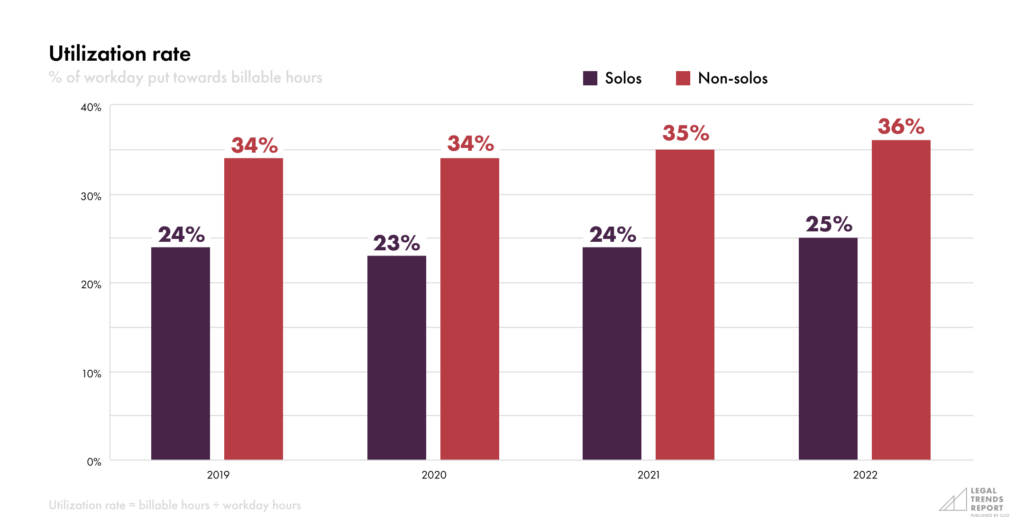
Even minor improvements to productivity can have significant benefits over the medium-to-long term.
Solos fall short on realization and collection
Realization rates have remained relatively high since 2019—however, they fell slightly in 2022. So, while firms were busier in terms of their average billables, they have not realized nor collected on that work as efficiently as in previous years.
Solos have realization rates that are 1% to 3% lower than non-solos and collection rates that are 2% lower. These lower realization rates mean that, in comparison, solos have a harder time billing for their time and collecting on what they are owed.
Given the amount of effort required to manage the administrative work in billing and following up on client payments, especially at scale, larger law firms may have the advantage of dedicated staff who can focus more explicitly on these tasks. Solo lawyers, who must do this work themselves, may need to find better, more efficient ways to manage these processes themselves if they want to improve them.
Part 4 looks at how the majority of solo lawyers have adopted cloud-based LPM software, which features robust workflows and automations to handle virtually any type of billing. Clio Manage in particular has seen substantial enhancements, featuring new capabilities for creating and sending bills in bulk, sending out automated bill reminders, managing and applying trust deposits to payments, and automated payment plans—all of which can help improve how lawyers bill and collect payments for their work.
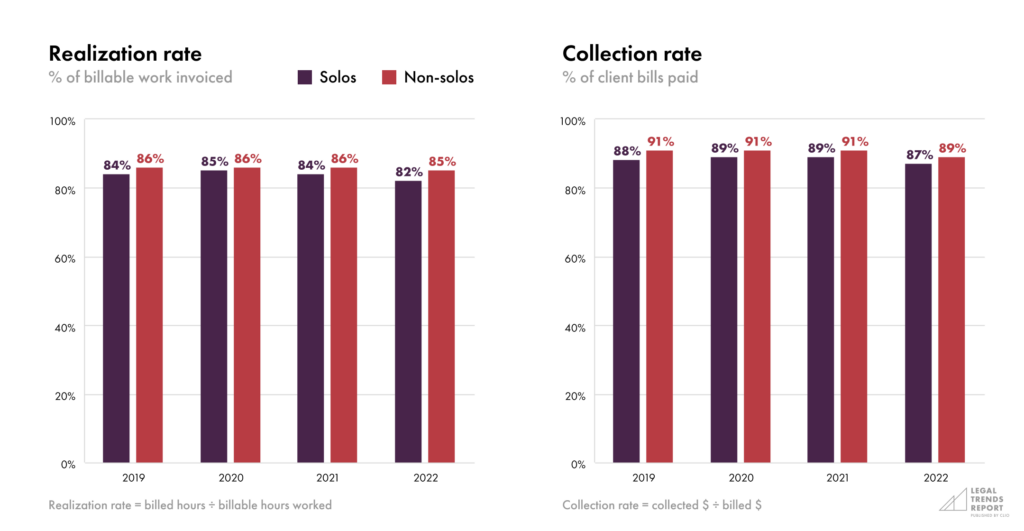
Perhaps not surprisingly, there is a striking difference between how much a solo lawyer charges compared to a non-solo, with solos charging a much lower rate. Since 2019, non-solo lawyers have consistently charged approximately 20% more per hour.
The gap in solo and non-solo hourly rates
Perhaps not surprisingly, there is a striking difference between how much a solo lawyer charges compared to a non-solo. Since 2019, non-solo lawyers have consistently charged approximately 20% more per hour. Even though they charge more, however, running a larger practice typically requires substantially higher costs, and a larger portion of a lawyer’s hourly rate goes to paying for them. Real estate costs alone can be a major cost for larger firms, as well as the salaries of support staff who often don’t contribute billable work to the firm.
Solos typically run leaner businesses with lower overhead and fewer partners to pay out. In many cases, these savings can be passed on to clients, allowing them to provide more affordable legal services. Charging lower rates may allow solos to maintain their competitiveness in the market for legal services and differentiate themselves from larger firms that often have more sophisticated operations and greater brand presence in the market.
Given that solo lawyers put less time toward billable hours, the fact that they also charge less means they bring in much less revenue to their firm on a per-lawyer basis. But hourly rates also don’t equate to take-home income. While solo lawyers appear to bring in less money to their firms, the amount they pay themselves may sometimes put them ahead of lawyers working at larger firms, which typically pay their associates after considering substantial operating costs and partner share-outs. But while some solos may come out ahead in some cases, this doesn’t mean that the majority are happy with their earnings.
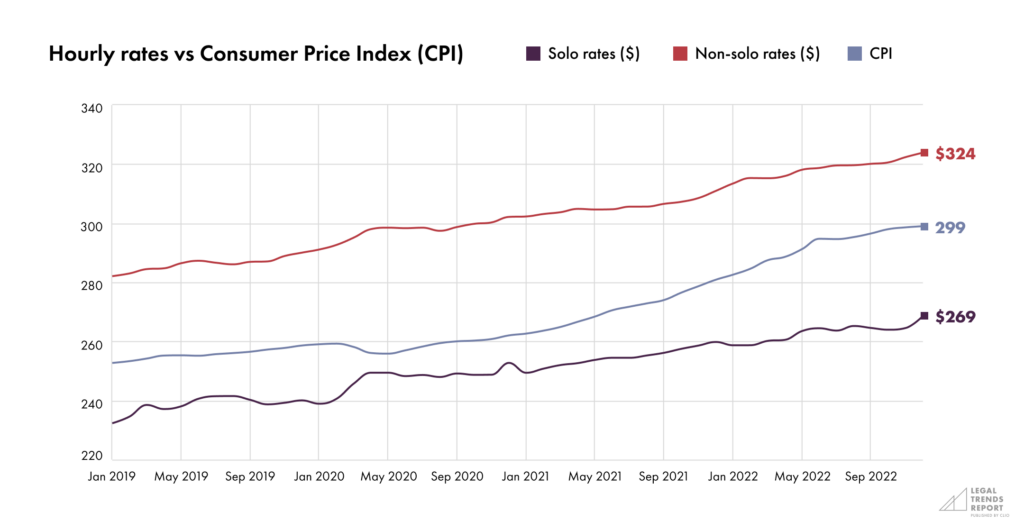
While solo lawyers appear to bring in less money to their firms, the amount they pay themselves may sometimes put them ahead of lawyers working at larger firms.
Hourly rates are rising but haven’t kept pace with inflation
Since the start of 2020, hourly rates for both solos and non-solos have steadily increased, likely in response to the challenges of the COVID-19 pandemic and costs resulting from rising interest rates and inflation. Within the first few months of 2020, hourly rates for solo lawyers increased by 4%. By the end of 2022, they were 11% higher.
Non-solo lawyers have increased their rates only slightly more than solos. The average rate for a non-solo lawyer in 2022 was just 12% higher than they were in 2019.
Still, solo lawyer hourly rates haven’t kept pace with inflation. The average cost of goods and services, as measured by the Consumer Price Index (CPI), increased by 16% during this time. Based on average hourly rates in 2022, both solos and non-solos would need to increase their rates by $12 per hour to keep pace with the CPI.
It’s worth noting that while solos and non-solos are collecting more overall, without actual gains in casework, the net difference may not be impactful for actual purchasing power and profitability since every dollar earned buys less than it did just a few years ago.
Solo lawyer hourly rates haven’t kept pace with inflation.
Where solos fall short (and where they succeed)
Overall, lawyers at larger firms are more likely to be happy with where they stand financially. They are 40% more likely than solos to be happy with the revenue they earn for their firm and 23% more likely to be happy with their personal income.2 Non-solos are also 15% more likely to have good time management, which may play into higher utilization rates that result in more revenue for their firms.
Solos, on the other hand, appear to have an advantage in other areas. They are 24% more likely to report having positive relationships with clients, which speaks to the type of hands-on, personal nature of the services that many solos pride themselves on. Solos are also slightly more likely to be happy with their professional lives (8% more) and their mental and emotional wellness (13% more), which may be circumstantial to the types of working arrangements they are free to create for themselves.
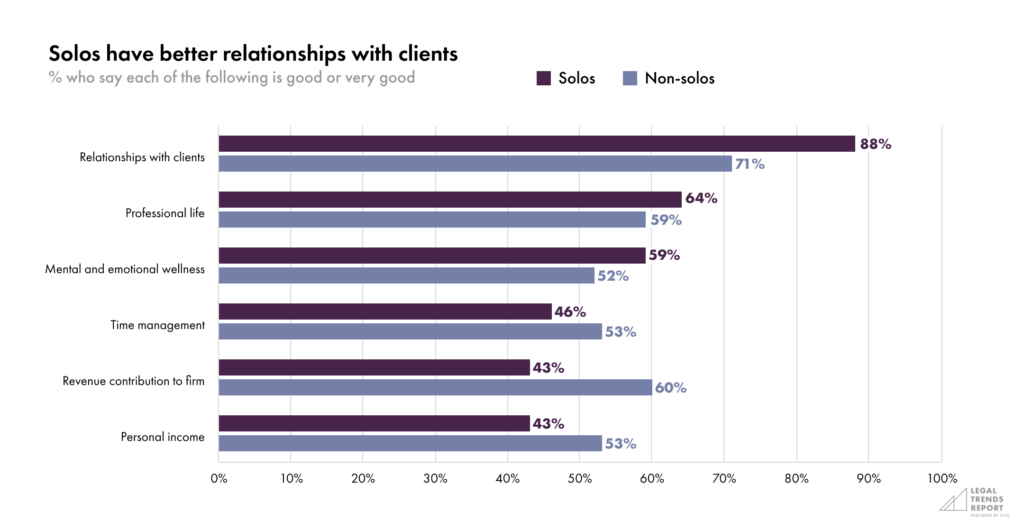
Solos are 24% more likely to report having positive relationships with clients.
Do solos prioritize freedom and flexibility over profit?
The overarching differences between solos and non-solos aren’t inherently bad. Every lawyer should decide what type of practice they want to work for, whether it’s their own or someone else’s, based on their preferences and where they are in their careers.
For solos, there is a benefit to being able to choose where and when one works and how much work they want to take on. At the same time, to work as a true solo is to accept the constraint that there are only so many hours in a day and that one lawyer can only do so much.
Leveraging the right technologies can ease the burden of wearing multiple hats, and help solos put more of their time into their most valuable work—while also maintaining the freedom of a flexible work schedule. Many solos have already found ways to leverage technology to extend their capabilities without overextending themselves, and Part 4 looks at ways solos can continue to expand their capacity while also consolidating costs.
The following sections will look at some of the underlying differences in how solos prefer to work, which provide insight into both the advantages that solos have in building relationships with clients, and how they may struggle to balance priorities between work and their personal lives.
Leveraging the right technologies can ease the burden of wearing multiple hats, and help solos put more of their time into their most valuable work.
[2] Percentages discussed in the report are relative comparisons of survey data findings.
2023
Legal Trends for Solo Law Firms
Part 2
Solos work in more than one location
- Introduction. What distinguishes a solo lawyer?
- Part 1. A widening gap
- Part 2. Solos work in more than one location
- Part 3. Pros and cons of flexible work schedules
- Part 4. Maintaining a competitive edge
- Appendix A. App data collection
- Appendix B. Survey design
As lawyers continue to prioritize better work-life balance, solo practice has the potential to become an even more attractive pursuit for many. The freedom to choose where and when to work is especially valuable to solos, who embrace more distributed work habits enabled by cloud-based virtual technologies.
As lawyers continue to prioritize better work-life balance, solo practice has the potential to become an even more attractive pursuit for many.
Solos make up a vital portion of the market for legal services
A key trend identified in the 2022 Legal Trends Report was that nearly one in five lawyers left a job earlier in that year, coinciding with the “Great Resignation,” a term coined to reflect the number of workers either changing jobs or leaving the workforce during that time.
In fact, 31% of the lawyers who quit their firms left to start their own solo practices. And while those now running a solo practice were nearly as likely to have left a previous role, they are much less likely to leave their firm to work for someone else.

This influx of new solo practices, combined with the lower attrition rate for solos, indicates that the market for solo lawyers is strong—if not thriving.
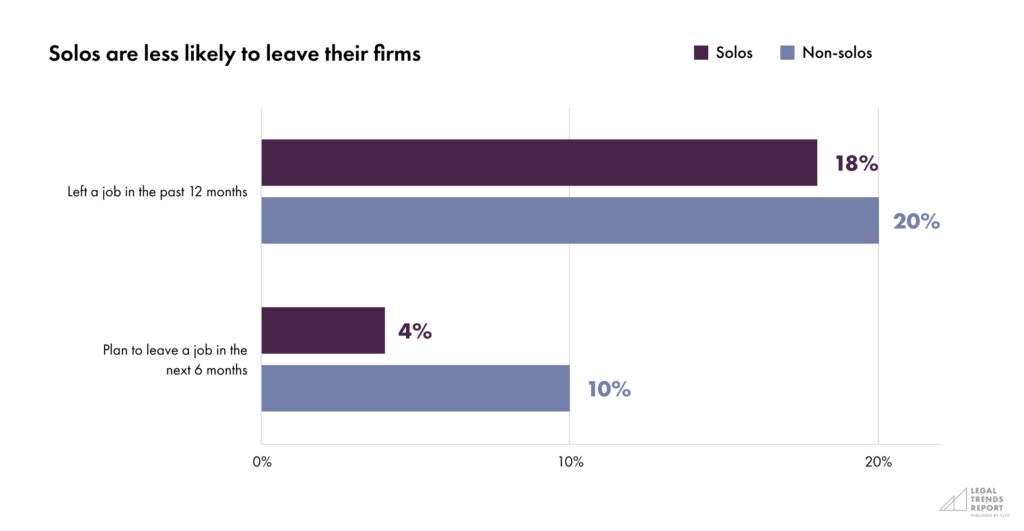
The market for solo lawyers is strong—if not thriving.
What’s the benefit of solo practice?
In the 2022 Legal Trends Report, which looks at data from lawyers working at firms of all sizes, better pay and work-life balance topped the list of reasons why lawyers either left or were considering leaving their roles.
For those seeking better pay, solo practice could be a viable option for many associate lawyers. Working for oneself—without having to pay into a larger firm’s overhead and partner shares—can be potentially more profitable for individual lawyers who want to work on their own. But as we saw in Part 1 of this report, most solos aren’t satisfied with their earnings.
In terms of work-life balance, however, solo practice offers more control in how lawyers manage their personal and professional lives—and being able to work a flexible schedule is key.
Not surprisingly, 62% of solo lawyers prefer working at home over a commercial office.
Since overhead is tied closely to the personal income of solo lawyers, working from home to avoid spending money on a commercial office offers a prime opportunity to operate more profitably, resulting in more money in their pockets. For solo lawyers who want more freedom and work-life balance, working from home also offers more opportunities to balance commitments in their personal lives. New innovations in technology make these types of working arrangements increasingly more seamless and convenient, for both legal professionals and their clients.
As long as legal professionals strive for more work-life balance and the flexible work arrangements needed to achieve it, with the help of technology, solo practice will continue to be a vital component of the market for legal services.
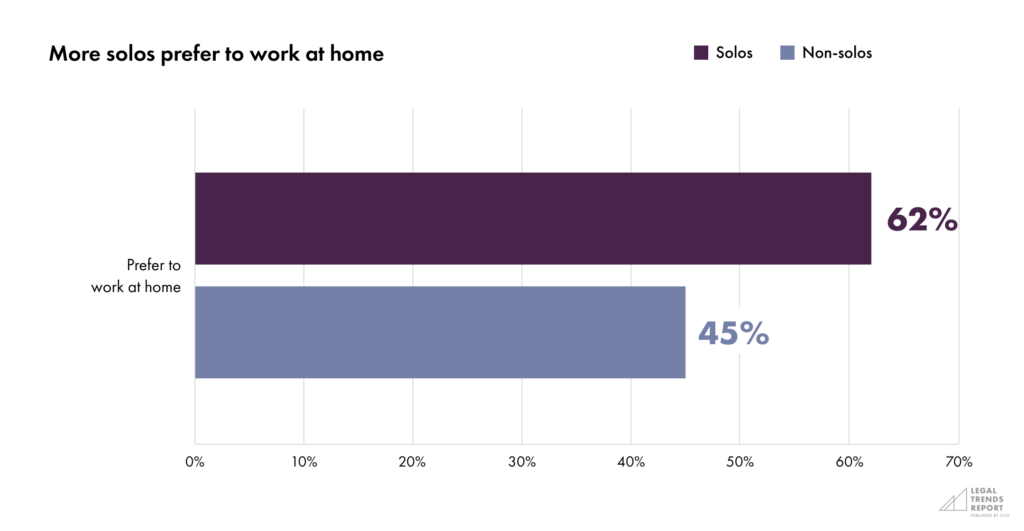
Solo lawyers are 38% more likely to prefer working at home over a commercial office.
Solos work in many locations
Data shows that solos don’t just prefer working from home. They work from more than one location, a trend that’s only increased—after a sharp decline at the start of the COVID-19 pandemic—since 2021.
Solos have always worked on the go, traditionally working in three to four different locations each month prior to 2020. Now, solos typically work across five locations each month. In other words, even among solo practitioners, legal work is becoming more distributed—and the flexibility and mobility of legal work is more essential than ever.
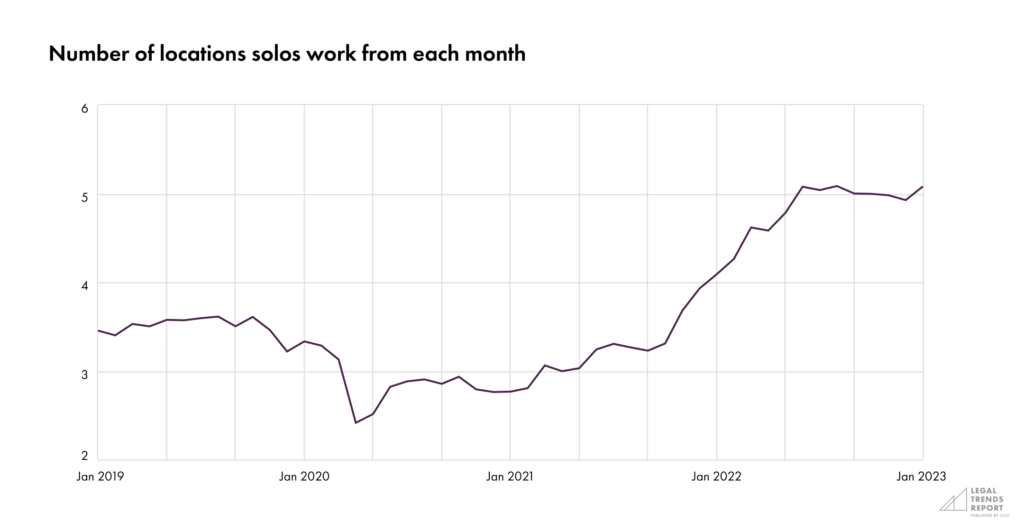
Where are lawyers working? Anywhere they want. Lawyers have traditionally had to make court appearances or house calls to meet clients where they are. Digital technologies, specifically cloud-based technology, allow lawyers to work more effectively outside the office by giving them access to all of the resources and information they would have had access to in their office.
Whether checking their calendar or pulling up documents stored in their virtual drive, lawyers are no longer tethered to a single location. Beyond where lawyers have traditionally worked, cloud-based solutions allow lawyers to work from virtually anywhere, whether from a temporary office in a coffee shop or while traveling abroad.
When looking at differences in the devices used to access their work in Clio, much of the increase in the last year has been through a laptop or desktop browser, suggesting that lawyers are bringing a computer to more locations to do their work.
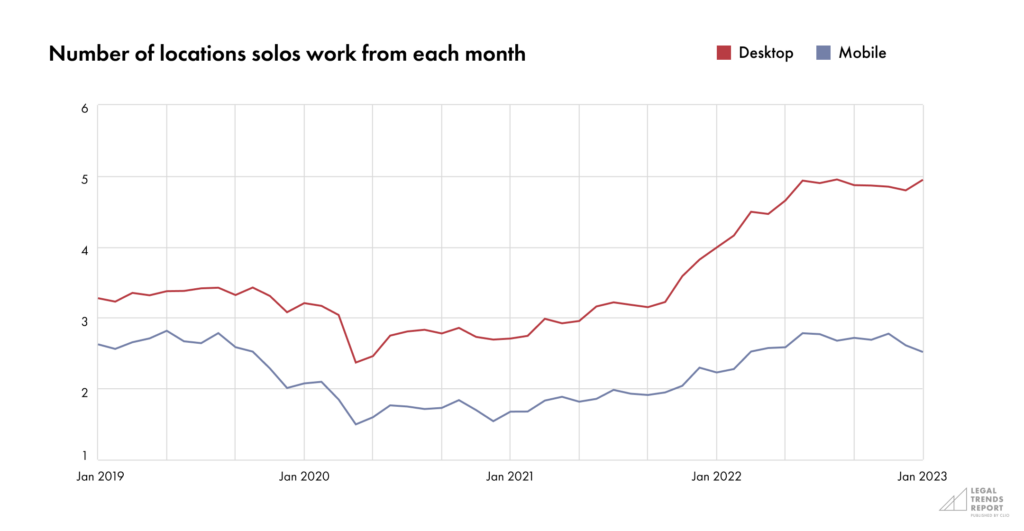
Even among solo practitioners, legal work is becoming more distributed.
Legal work has gone virtual
The trend of working in more locations has been enabled, and likely influenced, by technology innovations—especially cloud-based solutions—over the past decade.
Phone, email, and texting have been common mediums for client communications for quite some time, but video conferencing has become nearly universal—if not preferred—only in recent years. Among solos, 50% now prefer to meet clients virtually instead of in person.
One of the potential benefits of virtual communications is that they open opportunities to work outside of the immediate market. For example, two-thirds of solos want the option to work with clients in other states.
From a business perspective, being able to work with clients in other states could open up new market opportunities. On a more personal level, it also allows lawyers the freedom to travel while maintaining continuity with clients—whether it be while visiting family and friends, vacationing, or enjoying a change in scenery during a work residency somewhere else.
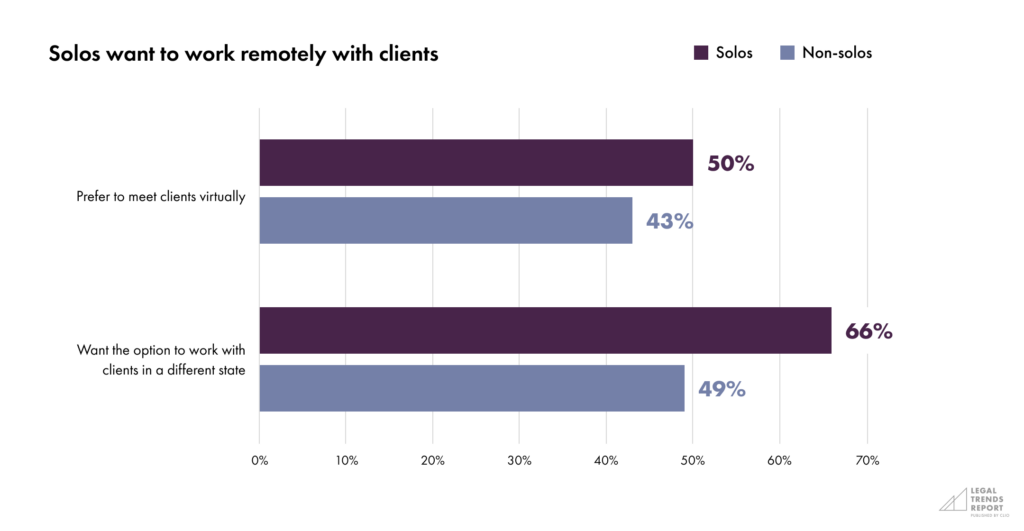
Among solos, 50% now prefer to meet clients virtually instead of in person.
The freedom to work anywhere, anytime requires balance with personal life
Solos need to consider how they can prioritize their work within the scope of their everyday lives. This consideration is especially relevant as more legal professionals—and solos in particular—work outside of traditional workspaces.
As the data in the next section suggests, working throughout the day may be beneficial to building strong client relationships. However, working outside of a traditional work schedule doesn’t necessarily translate to better revenue—and can also be a detriment to lawyers in other ways.
Solos need to consider how they can prioritize their work within the scope of their everyday lives.
2023
Legal Trends for Solo Law Firms
Part 3
Pros and cons of flexible work schedules
- Introduction. What distinguishes a solo lawyer?
- Part 1. A widening gap
- Part 2. Solos work in more than one location
- Part 3. Pros and cons of flexible work schedules
- Part 4. Maintaining a competitive edge
- Appendix A. App data collection
- Appendix B. Survey design
In Part 1, we saw that solos fare better in terms of their relationships with clients and slightly better in terms of their professional lives and mental and emotional well-being. We’ve also seen that solo lawyers have a strong preference for working remotely with clients near and far—and are exercising their freedom to work in more than one place through our research outlined in Part 2.
As we see in this section, solos are much more likely to be flexible with their time and when they are willing to meet with clients. We also see, however, that those who can also put limits on their time—as in, those who can keep their work within traditional working hours—are typically much better off than those who don’t.
Solos are much more likely to be flexible with their time and when they are willing to meet with clients.
Solo work goes beyond 9-to-5
Overall, solos are much more likely to prefer working between 9 a.m. and 5 p.m. While the freedom to choose their own hours is likely a major perk of being a solo lawyer, many also want to live and enjoy their lives outside of work. Despite these preferences, however, solos are much more likely than lawyers working at larger firms to work beyond 6 p.m.
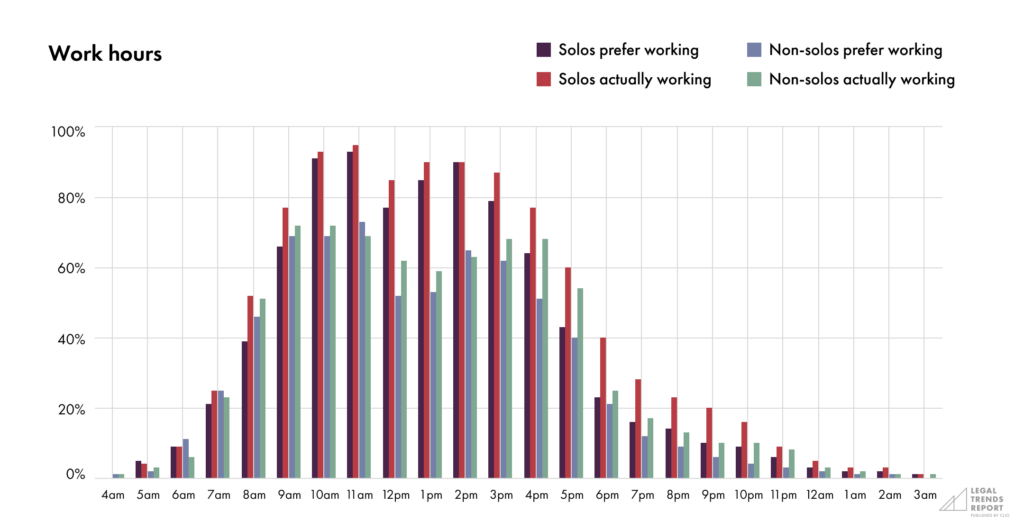
Similarly, solos are more likely to prefer working Monday to Friday over working on the weekend. Yet, more than half (54%) of solos report working Saturdays, and 40% say they work Sundays.
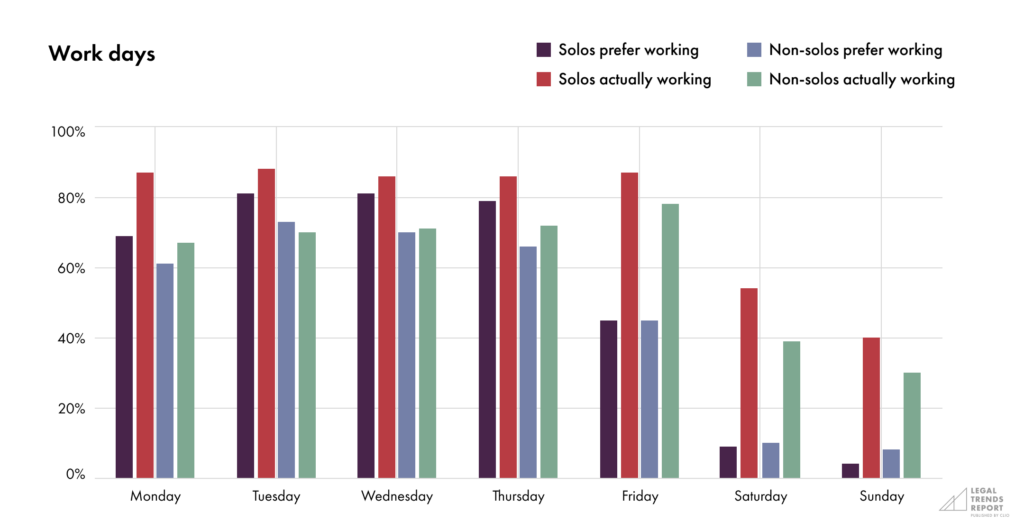
Since so many solo lawyers are working beyond the hours in which they want to work, finding ways to better manage important tasks can help open up time and ensure better work-life balance—which in turn can reduce the risk of burnout.
Certain technologies can provide the types of passive, “always-on” functionalities that give clients what they need, when they need it, without the direct attention of a lawyer. A dedicated client app, for example, provides access to all of the client’s case information—including documents and communications—which they can access at any time. With the ability to access this information themselves, clients have fewer reasons to reach out to their lawyer for answers to simple questions.
Other solutions like online payment solutions and online calendar scheduling provide similar services—allowing clients to pay bills or book appointments without having to reach out to the firm. These types of capabilities reduce the burden on lawyers while also creating better experiences for clients.
Solos are much more likely than lawyers working at larger firms to work beyond 6 p.m.
Solos value flexible work schedules
While solos generally prefer to work during traditional business hours, they are also more likely to want the flexibility to work when they want. Almost all solo lawyers want to be able to choose which hours of the day they work, and nearly nine in 10 want to be able to work outside of traditional business hours.
Being able to adapt work schedules has many benefits, as many solos need to account for personal conflicts or unforeseen circumstances that can take them away from their work during the day.
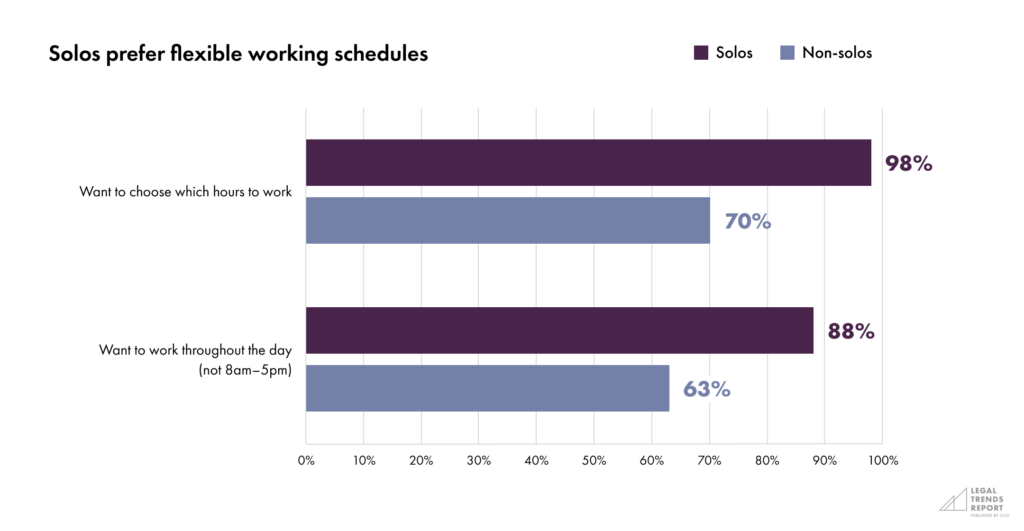
Solos are also more willing to make time for clients during evenings and weekends. And while work-life balance suggests that putting their personal time towards clients means that they can take time off during the work week, the problem for many solos is that they don’t necessarily get that time back for themselves. Solos are just as likely as lawyers working at larger firms to report working over 40 hours a week.
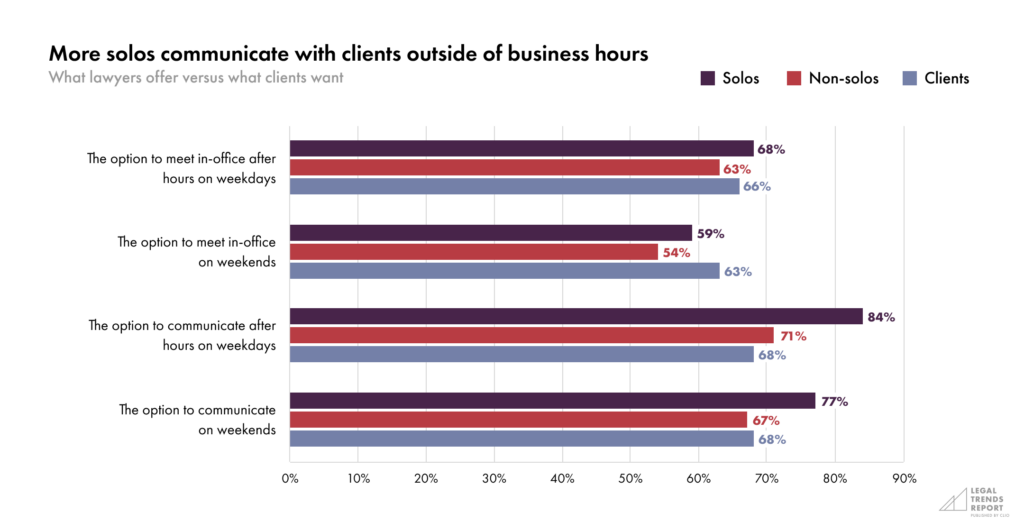
This is where cloud-based technologies have been a major boon for many solo law firms, since they provide secure access to firm information from anywhere. They provide the flexibility for lawyers to work where they want, but also the ability to access their work in the face of unforeseen circumstances. Even in the very worst of circumstances—e.g. a fire, flood, or other force majeure—lawyers using cloud-based practice management software can rest assured that all of their firm information is safe and secure.
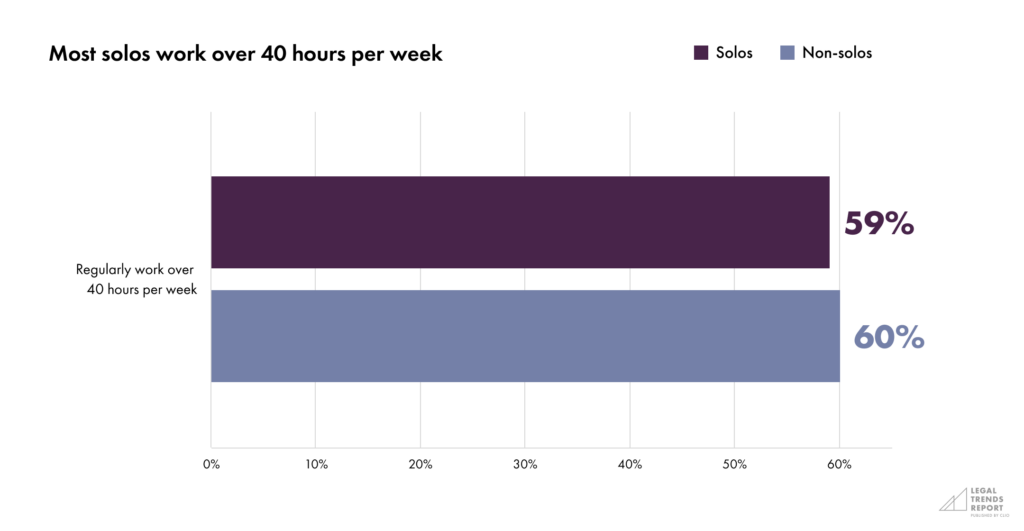
Solos are also more willing to make time for clients during evenings and weekends.
Many solos are at risk of poor mental health
As solos embrace more flexible work schedules, it’s often at the expense of time management, earnings for their firms, and most concerningly, their mental health.
While the vast majority of solos working regular business hours reported having positive mental and emotional wellness, nearly half of those working irregular schedules couldn’t say the same. Like many in the legal profession—but especially among solos—lawyers may need to assess how well they can balance work and life and how the dissonances between them can risk adverse outcomes for both.
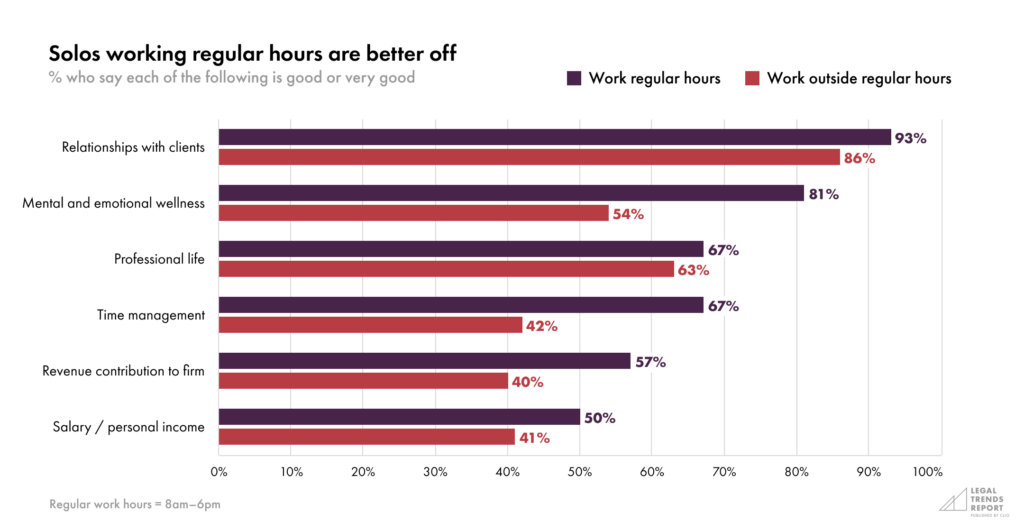
As solos embrace more flexible work schedules, it’s often at the expense of time management, earnings for their firms, and most concerningly, their mental health.
A need for better balance
While freedom and flexibility are valuable to many solo lawyers, many also stand to benefit from more boundary-setting and finding ways to realize the benefits of a flexible work schedule. Solos must find ways to be available without having it distract from personal life. Another opportunity is to find ways to introduce new efficiencies and automations through technology.
Solos must find ways to be available without having it distract from personal life.
2023
Legal Trends for Solo Law Firms
Part 4
Maintaining a competitive edge
- Introduction. What distinguishes a solo lawyer?
- Part 1. A widening gap
- Part 2. Solos work in more than one location
- Part 3. Pros and cons of flexible work schedules
- Part 4. Maintaining a competitive edge
- Appendix A. App data collection
- Appendix B. Survey design
Technology is evolving quickly, and solos have the ability to move and adapt quicker than larger businesses and organizations. We have already seen rapid uptake of cloud technologies among solo law firms. As larger firms close the gap on tech adoption, solos will need to find new opportunities to set them apart if they intend to continue leading innovation in legal services.
Technology is evolving quickly, and solos have the opportunity to move and adapt quicker than larger businesses and organizations.
Leaders in tech adoption
Solos remain ahead of the curve in cloud technology adoption: 85% use cloud-based legal practice management (LPM) software compared to 55% of non-solos. They are also much more likely to use online solutions for video conferencing, electronic payments, website design, e-signatures, and data storage.
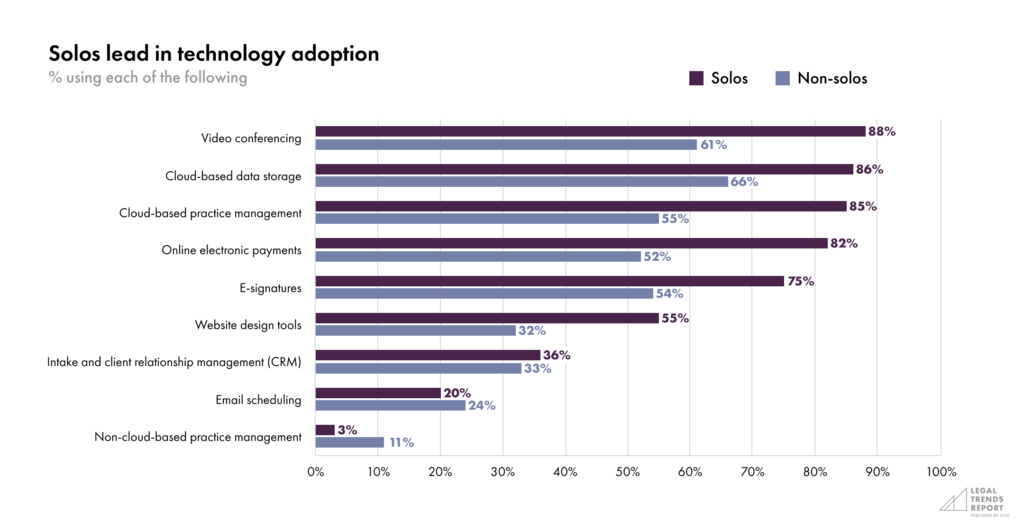
Any solo not using cloud-based solutions to manage their practice should take notice of the advantages that both solos and non-solos gain in using them (more on this below)—and the potential disadvantages and risks of falling behind when not using them.
But as cloud technologies become more pervasive among solo practitioners, they are also becoming the norm among larger firms. To remain competitive, solos must find new efficiencies and automations to help them maintain their edge in legal innovation. These advantages will not only help solos focus more on important billable work but will also support them in establishing work-life boundaries.
What does further innovation look like for solo lawyers? For many, this will come down to one of two goals:
- Consolidating tech investment. Finding ways to consolidate investments in technology to more integrated, platform-based solutions will ensure firms are able to store more information in one place, reduce complexity, and reduce costs by paying for fewer services. Clio Manage, for example, allows firms to consolidate firm workflows into one place with its comprehensive practice management features and seamless integrations with other essential business software.
- Invest in new capabilities. The legal technology market is in a state of constant evolution, and by exploring innovative ways to enhance their capabilities, law firms can unlock new efficiencies and improve the quality of service they provide to clients. For firms that have already invested in core cloud technologies, many will benefit from expanding the technology to help manage their intake and new client relationships.
Roughly two-thirds of law firms lack specialized software for client intake and customer relationship management (CRM), rendering it a substantial opportunity for all firms—but especially solo practices—to bolster their abilities. Dedicated intake and CRM software, like Clio Grow, helps firms increase their capacity for building client relationships upfront, and to be more competitive where it matters most: at the point and time of getting hired.
Clio Grow also offers tailored features for intake and client communications, such as:
- online calendar bookings
- email follow-ups and appointment reminders
- online intake forms
- e-signatures for retainers and fee agreements
These capabilities handle many client-facing tasks that would otherwise require a lawyer’s attention. They enable the firm to maintain a high level of client service on the lawyer’s behalf at the critical first stage of building a relationship with clients. At the same time, they allow the lawyer to step away to focus on other work or even take time away from work.
Clio Grow integrates seamlessly with Clio Manage. Together, they provide the means for lawyers to manage every step—and all the information involved—of a client’s relationship with the firm, from the initial intake to the point of getting paid.
Dedicated intake and CRM software, like Clio Grow, helps firms increase their capacity for building client relationships upfront—and to be more competitive where it matters most: at the point and time of getting hired.
Cloud enables more flexible work styles
Among solos, the use of cloud-based LPM software is nearly ubiquitous with the desire to work flexible hours: 98% of solos using cloud-based LPM want the autonomy to choose which hours of the day they work, and 89% prefer to work throughout the day (not just between 8 a.m. and 5 p.m.).
Of those using cloud-based LPM software, solos are also more likely than non-solos to communicate with clients on weekends and after hours—and they are less likely to work more than 40 hours per week.
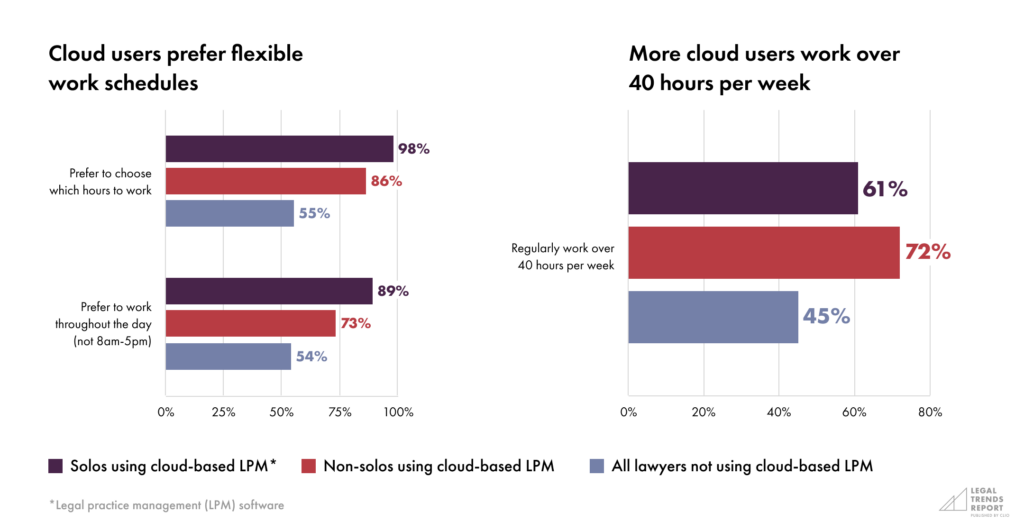
While cloud users make themselves available to clients more often, they are less likely to meet in person on evenings and weekends—in other words, they are more willing to meet virtually or on the phone. These are the types of advantages that technology can create—enhanced services that require less effort and disruption to a lawyer’s personal time.
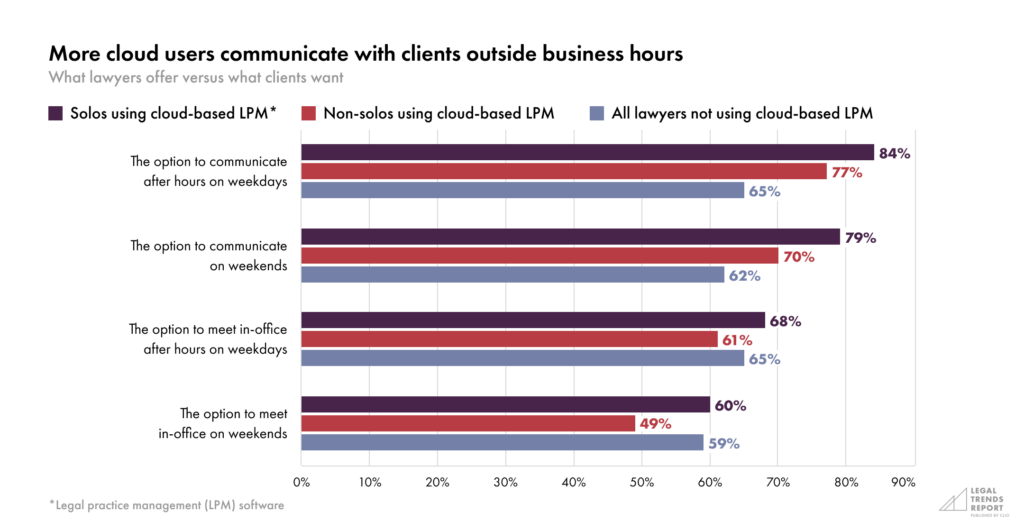
These are the types of advantages that technology can create—enhanced services that require less effort and disruption to a lawyer’s personal time.
Everyone benefits from cloud technologies
Compared to lawyers who aren’t using cloud technologies (working in firms of all sizes), solos who are using cloud-based LPM software are 62% more likely to be happy with their client relationships. Solos using cloud-based LPM software are also 24% more likely to report being happy with their professional life and 21% more likely to be satisfied with their own mental and emotional wellness.
However, solos using cloud-based LPM software fall short when comparing time management and overall firm earnings. Since most solo lawyers are using these solutions, comparing to firms not using cloud-based LPM software is largely a comparison to larger firms, which as we’ve seen in Part 1, generally see better results in these areas.
Yet, while lawyers at larger firms are happier with how much they earn, those using cloud-based LPM software report even better results. In fact, larger firms using cloud-based LPM software are just as likely as solos to report positive results with respect to their relationships with clients, professional satisfaction, and mental and emotional wellness—all areas where solos typically see better results compared to non-solos.
The takeaway here is more than clear. Using cloud-based LPM software offers significant benefits to both solo lawyers and larger law firms. As larger firms continue to acquire the benefits of these technologies, they’ll also enhance their services in a way that will help them realize more business and capture more market share. To remain competitive, solos will need to find new ways to distinguish themselves from larger firms in ways that are attractive to potential clients.
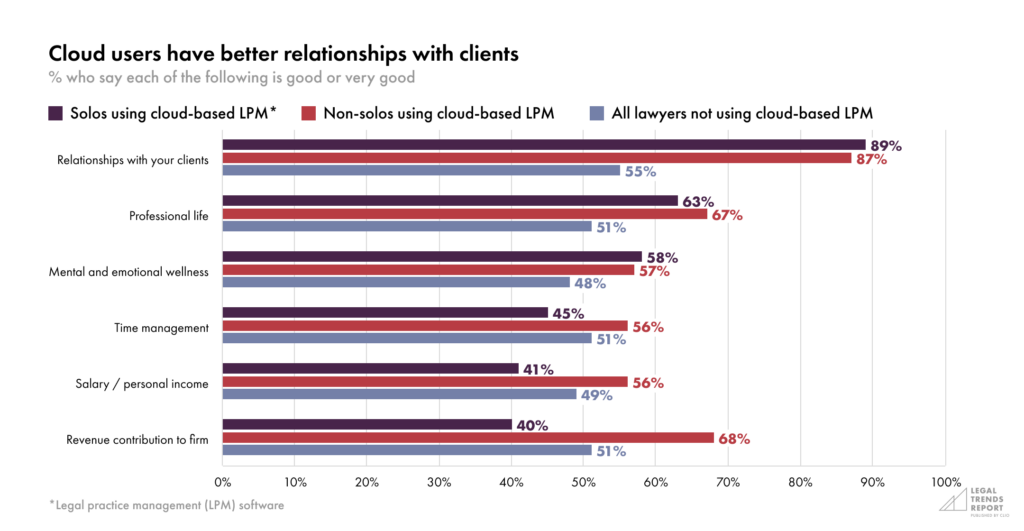
Using cloud-based LPM software offers significant benefits to both solo lawyers and larger law firms.
Future innovation of solo practice
As solos continue to prioritize flexible work arrangements for themselves and their clients, they should take note of the increased uptake of cloud technology among larger firms. At the same time, they should look for solutions that not only enhance their services but help prioritize their own personal lives as well.
Three focus areas for solo law firms include:
- Finding ways to set boundaries on their time while maintaining responsiveness to clients. Technology offers several opportunities to support solo lawyers. Client apps, electronic payments, and e-signatures included in practice management solutions like Clio Manage give clients what they need—even outside of business hours—without the direct attention of a lawyer.
- Expanding capabilities to cover more essential workflows. Two thirds of law firms don’t have a dedicated intake/CRM solution to manage new clients. Solutions like Clio Grow offer features like online calendar bookings, email follow-ups and appointment reminders, online intake forms, e-signatures, and lead management. These features help improve experiences and efficiency when building new relationships with clients.
- Upgrading practice management systems. Investing in cloud technologies can help realize significant short-term gains that will only pay off exponentially over the longer term. For any solo lawyer not using cloud-based technology, solutions like Clio Manage and Clio Grow will help organize firm information and processes to increase efficiency while enabling the ability to work from anywhere, at any time.
Clio Manage and Clio Grow help organize firm information and processes to increase efficiency while enabling the ability to work from anywhere, at any time.
Staying at the forefront of innovation
Solo lawyers continue to make up a substantial segment of the market for legal services, and their success largely stems from their ability to balance their own needs with those of their clients. Technology offers a powerful means to help solos achieve their goals. If solos stay at the forefront of these innovations, they will continue to shape the practice of law in ways that benefit themselves, their profession, and their clients.
Solo lawyers continue to make up a substantial segment of the market for legal services, and their success largely stems from their ability to balance their own needs with those of their clients.
2023
Legal Trends for Solo Law Firms
Appendix A
App data collection
- Introduction. What distinguishes a solo lawyer?
- Part 1. A widening gap
- Part 2. Solos work in more than one location
- Part 3. Pros and cons of flexible work schedules
- Part 4. Maintaining a competitive edge
- Appendix A. App data collection
- Appendix B. Survey design
The Legal Trends for Solo Law Firms report uses aggregated and anonymized data collected from the Clio platform. By synthesizing usage data, we’re able to identify trends that would be otherwise invisible to most firms.
The Legal Trends Report relies on data aggregated and anonymized from tens of thousands of legal professionals. These customers were included in our data set using the following criteria:
- They were paid subscribers to Clio. Customers evaluating the product via a free trial or using Clio as part of our Academic Access Program were not included.
- They were located in the contiguous United States, including the District of Columbia but excluding Hawaii and Alaska. Customers in other countries were not included.
- Any data from customers who opted out of aggregate reporting were excluded.
- Outlier detection measures were implemented to systematically remove statistical anomalies.
Data use and privacy
The security and privacy of customer data is our top priority at Clio. In preparing the Legal Trends Report, Clio’s data operations team observed the highest data collection and reporting standards.
Data collection
- All data insights were obtained in strict accordance with Clio’s Terms of Service (section 2.12).
- All extracted data was aggregated and anonymized.
- No personally-identifiable information was used.
- No data belonging to any law firm’s clients was used.
Reporting
Aggregate data has been generalized where necessary to avoid instances where individual firm data could be identified. For example, to avoid reporting data on a small town with only one law firm, which would attribute all of this town’s data to this firm, we only report at country, state, and metropolitan levels.
Additionally, raw data sets will never be shared externally. Clio is effectively a tally counter for user interactions—much like stadiums use turnstiles to count visitors without collecting any personally-identifiable information from their customers. Similarly, as users interact with the Clio platform, they trigger usage signals that we can count and aggregate into data sets. We can identify trends without collecting information that reveals anything specific about individual customers.
2023
Legal Trends for Solo Law Firms
Appendix B
Survey design
- Introduction. What distinguishes a solo lawyer?
- Part 1. A widening gap
- Part 2. Solos work in more than one location
- Part 3. Pros and cons of flexible work schedules
- Part 4. Maintaining a competitive edge
- Appendix A. App data collection
- Appendix B. Survey design
This year’s Legal Trends Report includes survey data collected during April and May 2022.
Survey of US legal professionals
1,134 respondents
Survey of US consumers (general population)
1,168 respondents
Survey respondents were representative of the US population by age, gender, region, income, and race/ethnicity, according to US census statistics.
Survey of professionals from other industries in the US
458 respondents
Survey respondents were representative of the following professions: accounting, architecture, business consulting, data security, engineering, event planning, financial services and investment, insurance, marketing/ advertising, public relations, real estate, tax preparation (non-accountant), and transportation/logistics.
